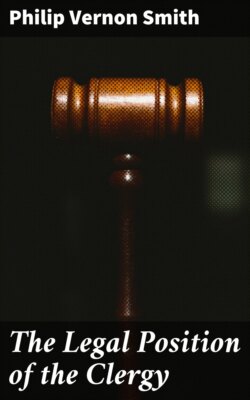Читать книгу The Legal Position of the Clergy - Philip Vernon Smith - Страница 19
На сайте Литреса книга снята с продажи.
Оглавление13. Judicial procedure in the case of clerical offences is regulated by three statutes of the last century: (i.) The Church Discipline Act, 1840,[22] provides that on a complaint or the existence of evil report against a clergyman the bishop may, with the consent of the parties, at once pronounce sentence, and, in the absence of such consent, may, if he thinks fit, issue a commission of inquiry. If the commission reports that there is primâ facie ground for proceedings, the bishop may either try the case in person with assessors, or else send it by letters of request direct to the provincial court. The latter course has in practice been generally adopted, and an appeal may be carried to the Judicial Committee of the Privy Council. (ii.) The Public Worship Regulation Act, 1874,[23] introduced an alternative procedure in matters of ornament and ritual. On the representation of the archdeacon or a churchwarden or any three parishioners, the bishop, unless he is of opinion that no proceedings should be taken upon it, is to require the parties to state whether they are willing to submit to his directions in the matter, and if they assent he is to hear the case and pronounce judgment as he thinks proper, and no appeal is to lie from his judgment. But if they decline to submit the case to the bishop, it is to be heard by the judge appointed under the Act, who is in fact the same person as the judge of the two provincial courts, and an appeal lies from his decision to the Judicial Committee. (iii.) The Clergy Discipline Act, 1892,[24] prescribed a new mode of dealing with offences against morality. In certain cases where the offence is proved by a conviction and sentence or an order of a temporal court, the offending clergyman is to be incapable of holding preferment, and the bishop is to declare vacant any preferment which he holds without any further trial. But in all other cases proceedings are to be taken in the consistory court before the chancellor of the diocese, with the addition of four assessors to try any question of fact, if either party demands them. Either party may appeal against the judgment of the consistory court on a question of law, and the accused clergyman may, with the leave of the appellate court, appeal on a question of fact. The appeal may at the option of the appellant be either to the provincial court or to the Judicial Committee of the Privy Council, but if it is made to the provincial court the decision of that court is final. The net result of the three Acts is that (i.) offences of the clergy in respect of morality can only be dealt with under the Act of 1892; (ii.) proceedings for offences in respect of ritual and the ornaments of the church or the minister may be taken either under the Act of 1840 or under that of 1874; and (iii.) offences in respect of doctrine, as well as all other offences which do not come under (i.) or (ii.), must be dealt with under the Act of 1840.
